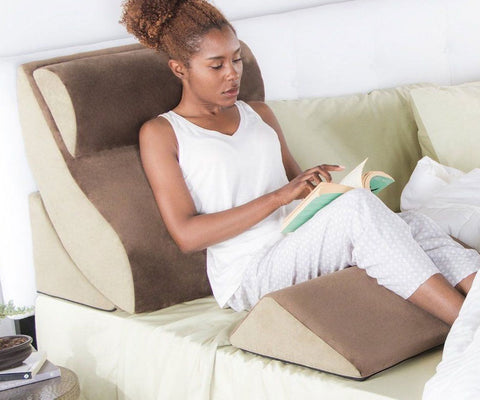Sleep quality significantly impacts overall health and well-being. Your pillow plays a crucial role in achieving restful sleep by providing proper support for your head, neck, and spine alignment.
The correct pillow position can alleviate discomfort, reduce pain, and improve sleep quality. Understanding how to use your pillow effectively based on your sleeping position can make a substantial difference in your nightly rest. This article will explore 12 practical tips to help you sleep correctly with your pillow, enhancing your sleep experience and promoting better health.
1) Choose the right pillow height
Selecting the correct pillow height is crucial for proper spinal alignment and a good night's sleep. Your ideal pillow height depends on your sleeping position and body type.
For side sleepers, a pillow between 5 to 7 inches high is generally recommended. This helps fill the space between your neck and shoulders, keeping your spine straight.
Back sleepers typically need a pillow around 4 to 5 inches high. This height supports your neck without pushing your head too far forward.
Stomach sleepers require the thinnest pillows, usually 2 to 3 inches high. A flatter pillow prevents your neck from bending upward at an uncomfortable angle.
Consider your body size as well. Petite individuals may need pillows on the lower end of these ranges, while those with larger frames might prefer pillows on the higher end.
If you're unsure, try using a pillow height calculator. These tools take into account your height, weight, and sleeping position to provide a personalized recommendation.
Remember, the goal is to keep your head, neck, and spine in a neutral alignment. Adjust your pillow height until you find the most comfortable position for you.
2) Use a pillow for neck support
Neck support is crucial for proper sleep posture. A dedicated neck pillow can help maintain the natural curve of your cervical spine while you rest.
When using a neck pillow in bed, choose one that fills the space between your neck and the mattress. This ensures your neck stays aligned with your spine as you sleep.
For back sleepers, place the thicker part of the pillow under your neck. This cradles your head and provides adequate support.
Side sleepers should position the pillow between their neck and shoulder. Make sure it comfortably fills the gap to prevent strain.
If you're traveling, use a U-shaped neck pillow. Place it around your neck with the opening at the back for optimal head support. This prevents your head from falling to the side during sleep.
When driving long distances, use your neck pillow to support your neck and reduce fatigue. Position it so your head remains upright and comfortable.
Remember to adjust your neck pillow as needed to maintain proper alignment throughout the night or during your journey. This helps prevent neck pain and stiffness upon waking.
3) Place a pillow under your knees
Placing a pillow under your knees can significantly improve your sleep quality and comfort. This technique is especially beneficial for back sleepers.
By elevating your knees slightly, you reduce stress on your lower back. The pillow helps maintain the natural curve of your spine, promoting proper alignment throughout the night.
This position can alleviate pressure on your lumbar region and ease discomfort for those with lower back pain. It may also help reduce swelling in your legs by improving circulation.
Choose a pillow that's firm enough to provide support but soft enough for comfort. Experiment with different heights to find what works best for you.
Remember to adjust your head pillow accordingly when using a knee pillow. This ensures your entire spine remains properly aligned from head to toe.
If you switch positions during the night, try to reposition the pillow. Consistency in maintaining this supportive posture can lead to better sleep and reduced pain over time.
4) Align your head and spine
Proper alignment of your head and spine is crucial for a restful sleep. When lying down, ensure your pillow supports your neck in a neutral position.
Your head should be level with your shoulders, neither tilted up nor down. This maintains the natural curve of your cervical spine.
For side sleepers, choose a pillow that fills the space between your ear and shoulder. This keeps your neck straight and aligned with your spine.
Back sleepers benefit from a thinner pillow that supports the neck without pushing the head forward. A small roll under your neck can provide additional support.
If you sleep on your stomach, use a very thin pillow or no pillow at all to avoid straining your neck. Consider placing a pillow under your hips to reduce lower back stress.
Experiment with different pillow heights and materials to find the perfect fit for your sleeping position. Memory foam or adjustable pillows can be particularly helpful in achieving proper alignment.
Remember, your goal is to keep your spine in a neutral position throughout the night. This reduces strain on your muscles and joints, promoting better sleep quality and fewer aches in the morning.
5) Choose breathable pillow materials
Selecting breathable materials for your pillow can significantly improve your sleep quality. Opt for natural fibers like cotton, bamboo, or linen for pillow covers. These allow air to circulate and help regulate temperature.
For pillow fills, consider materials like shredded memory foam, latex, or buckwheat hulls. These promote airflow and prevent heat buildup during the night.
Wool is another excellent choice for its moisture-wicking properties. It keeps you cool in summer and warm in winter, adapting to your body temperature.
Avoid synthetic materials that trap heat and moisture. These can lead to discomfort and potentially promote allergen growth.
Remember, a breathable pillow helps maintain a comfortable sleeping environment. It reduces night sweats and keeps you feeling fresh throughout your sleep.
When shopping, look for pillows labeled as "cooling" or "temperature-regulating." These often incorporate breathable materials designed to enhance sleep comfort.
6) Use a pillow between your legs
Placing a pillow between your legs while sleeping can significantly improve your sleep quality and comfort. This technique is especially beneficial for side sleepers.
When you sleep on your side without a pillow between your legs, your upper leg tends to pull your spine out of alignment. A pillow helps maintain proper spinal alignment and reduces strain on your lower back and hips.
For optimal results, choose a pillow that's firm enough to maintain its shape throughout the night. Place it between your knees and thighs, extending it down to your ankles if possible.
This position helps keep your hips, pelvis, and spine in a neutral alignment. It can alleviate pressure on your lower back and potentially reduce pain or discomfort in this area.
Pregnant women often find this technique particularly helpful. It can provide support for the growing belly and relieve pressure on the lower back and hips.
If you're a back sleeper, you can still benefit from this technique. Try placing a pillow under your knees instead. This helps maintain the natural curve of your spine and reduces stress on your lower back.
7) Try a pillow for side sleepers
Side sleeping requires specific pillow support to maintain proper spinal alignment. A side sleeper pillow is designed to fill the gap between your shoulder and neck.
Look for a pillow with the right shape. It should have a flatter area for your head and a curve or bump to support your neck. This helps keep your spine in a neutral position.
Consider the thickness of the pillow. Side sleepers typically need a thicker pillow, around 4 to 6 inches, to bridge the space between your shoulder and the mattress.
Choose a pillow with good pressure relief. Memory foam or shredded foam pillows can contour to your head and neck, providing customized support.
Temperature regulation is important for comfort. Some side sleeper pillows feature cooling technologies to help you stay comfortable throughout the night.
Try different materials to find what works best for you. Options include memory foam, down, down alternative, and latex. Each has unique properties that may suit your preferences.
8) Opt for a memory foam pillow
Memory foam pillows offer excellent support for your head and neck. These pillows conform to your unique shape, providing consistent pressure relief throughout the night.
Many memory foam pillows are adjustable, allowing you to customize the loft to your preferred sleeping position. This adaptability makes them suitable for side, back, and stomach sleepers alike.
Memory foam retains its shape well, helping maintain proper spinal alignment as you sleep. This can reduce neck pain and stiffness in the morning.
Some memory foam pillows incorporate cooling technologies to address heat retention concerns. Look for options with gel-infused foam or ventilated designs for improved temperature regulation.
These pillows are often hypoallergenic and resistant to dust mites, making them a good choice for allergy sufferers. They're also generally durable, lasting longer than traditional pillows.
When selecting a memory foam pillow, consider factors like density and firmness to ensure it meets your comfort preferences. Try out different options to find the one that best supports your sleeping style.
9) Consider an adjustable pillow
Adjustable pillows offer versatility for various sleep positions and preferences. These pillows allow you to add or remove filling to customize the loft and firmness to your liking.
If you switch between sleeping positions throughout the night, an adjustable pillow can accommodate your changing needs. You can modify the pillow's height and support level to suit your current position.
Adjustable pillows are particularly useful if you're unsure about your ideal pillow height or firmness. They give you the flexibility to experiment and find the perfect configuration for your comfort.
Some adjustable pillows come with different types of filling, such as shredded memory foam or a combination of materials. This allows you to fine-tune the pillow's feel and support.
When using an adjustable pillow, take time to test different fill levels. Pay attention to how your neck and spine align in your preferred sleep position. Adjust accordingly until you find the most comfortable and supportive setup.
10) Utilize a cooling pillow
Cooling pillows can enhance your sleep quality, especially if you tend to overheat at night. These pillows are designed with special materials or technologies to help regulate temperature.
Many cooling pillows use gel-infused memory foam or phase-change materials. These components help dissipate heat and maintain a comfortable sleeping surface throughout the night.
Some cooling pillows feature breathable covers made from moisture-wicking fabrics. These materials allow air to circulate more freely, preventing heat and moisture buildup.
When choosing a cooling pillow, consider your preferred sleeping position and firmness level. Look for options that provide adequate support while offering cooling properties.
To maximize the benefits of your cooling pillow, pair it with breathable bedding. Light, airy sheets and pillowcases can complement the pillow's cooling effects.
Remember that cooling pillows may feel cool to the touch initially but will warm up with use. Their primary function is to help regulate temperature rather than stay cold all night.
11) Switch pillows regularly
Rotating your pillows can help extend their lifespan and maintain optimal support. Consider switching between multiple pillows throughout the week to distribute wear evenly.
This practice allows each pillow time to regain its shape between uses. It also helps prevent excessive buildup of oils, sweat, and allergens on a single pillow.
You might want to keep a few different types of pillows on hand. This allows you to adjust based on your sleep needs or physical condition on any given night.
For example, you could alternate between a firmer pillow for nights when you need extra support and a softer one for more relaxed sleep. This variety can improve your overall sleep quality.
Remember to fluff your pillows daily and wash them regularly according to care instructions. These habits, combined with regular rotation, will help keep your pillows in good condition for longer.
12) Avoid too many pillows
Using excessive pillows can disrupt your sleep quality and posture. While it may seem cozy, piling on pillows can misalign your spine and neck.
Stick to one or two pillows for optimal comfort and support. A single pillow is often sufficient for most sleepers, especially when sleeping on your back or stomach.
Side sleepers might benefit from two pillows - one for head support and another between the knees. This helps maintain proper spinal alignment throughout the night.
Excess pillows can cause your head to tilt at an unnatural angle, leading to neck pain and stiffness upon waking. They may also shift during sleep, disrupting your rest.
If you find yourself constantly adjusting multiple pillows, it's a sign you may be using too many. Consider reducing the number and focusing on quality over quantity.
Remember, the goal is to keep your head and neck aligned with your spine. Too many pillows can interfere with this natural positioning and compromise your sleep quality.
Choosing the Right Pillow
Selecting an appropriate pillow is crucial for optimal sleep quality and spinal alignment. The right choice depends on your sleeping position, body type, and personal preferences.
Pillow Material Options
Memory foam pillows contour to your head and neck, providing customized support. They're ideal for those with neck pain or who sleep in multiple positions. Latex pillows offer similar benefits but with more bounce and breathability.
Down pillows are soft and moldable, perfect for stomach sleepers who need minimal lift. Polyester or down alternative pillows are hypoallergenic and budget-friendly options that mimic down's softness.
Buckwheat pillows allow for adjustable support by adding or removing hulls. They're great for those who frequently change sleeping positions.
Pillow Firmness Levels
Side sleepers typically need firm pillows to fill the gap between their head and shoulders. A medium-high loft helps maintain proper spinal alignment.
Back sleepers benefit from medium-firm pillows that cradle the head without pushing it forward. A medium loft usually works well for this position.
Stomach sleepers should opt for soft, thin pillows to minimize neck strain. Low loft pillows help keep the spine in a neutral position.
Remember to consider your body size and weight when choosing firmness. Heavier individuals may need firmer pillows, while lighter people might prefer softer options.
Pillow Positioning Techniques
Proper pillow positioning is crucial for maintaining spinal alignment and reducing discomfort during sleep. The ideal technique varies based on your preferred sleeping position.
Back Sleepers
For back sleepers, place a medium-loft pillow under your head and neck. This helps maintain the natural curve of your spine. The pillow should support your head without pushing it forward or allowing it to tilt back excessively.
Consider adding a small pillow under your knees. This slight elevation can reduce pressure on your lower back and promote better spinal alignment.
Experiment with pillow thickness to find the right balance. Your head should rest comfortably without straining your neck muscles.
Side Sleepers
Side sleepers need a thicker pillow to fill the gap between the shoulder and head. Choose a firm pillow that keeps your head aligned with your spine.
Place the pillow close to your shoulders to support your neck fully. Your ear should align with your shoulder to maintain proper spinal alignment.
Try placing a pillow between your knees. This helps keep your hips level and reduces strain on your lower back and hips.
For additional comfort, you can hug a body pillow. This can help align your shoulders and provide support for your arms.
Stomach Sleepers
Stomach sleeping can strain your neck and lower back. If you must sleep on your stomach, use a very thin pillow or no pillow at all under your head.
Place a thin pillow under your pelvis and lower abdomen. This helps maintain the natural curve of your spine and reduces lower back strain.
Consider hugging a pillow to your chest. This slight elevation can help reduce the twist in your neck and upper back.
Try gradually transitioning to side or back sleeping for better spinal alignment. Use pillow barriers on either side to prevent rolling onto your stomach during the night.
Maintaining Pillow Hygiene
Proper pillow hygiene is essential for a healthy sleep environment. Regular cleaning and timely replacement of your pillow can significantly improve your sleep quality and overall health.
Cleaning and Washing
Wash your pillow every 3-6 months to remove sweat, oils, and allergens. Check the care label for specific instructions. Most synthetic pillows are machine washable using warm water and mild detergent. Run an extra rinse cycle to remove all soap residues.
For down or feather pillows, use a gentle cycle with warm water. Memory foam pillows should be spot cleaned with a damp cloth and mild soap. Never machine wash them.
Dry pillows thoroughly to prevent mold growth. Use dryer balls or clean tennis balls to fluff pillows while drying. Sun exposure can help eliminate bacteria and odors.
Between washes, vacuum your pillow regularly and use a pillow protector. Change pillowcases weekly to maintain cleanliness.
Replacing Your Pillow
Replace your pillow every 1-2 years to ensure optimal support and hygiene. Memory foam pillows may last up to 3 years, while down pillows can last up to 5 years with proper care.
Signs it's time for a new pillow:
- Visible lumps or flat spots
- Persistent odors
- Yellowing or stains
- Increase in allergy symptoms
- Waking up with neck pain
To test if your pillow needs replacing, fold it in half. If it doesn't spring back to its original shape, it's time for a new one.
When buying a new pillow, consider your sleep position and personal preferences. A pillow that supports your neck and aligns your spine is crucial for restful sleep.



